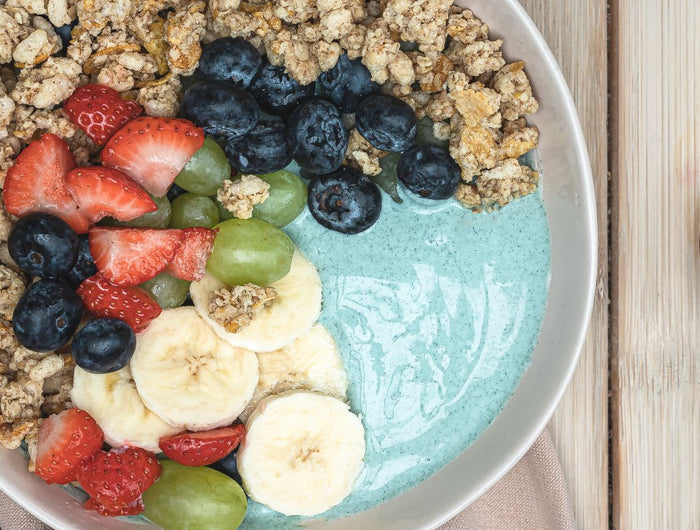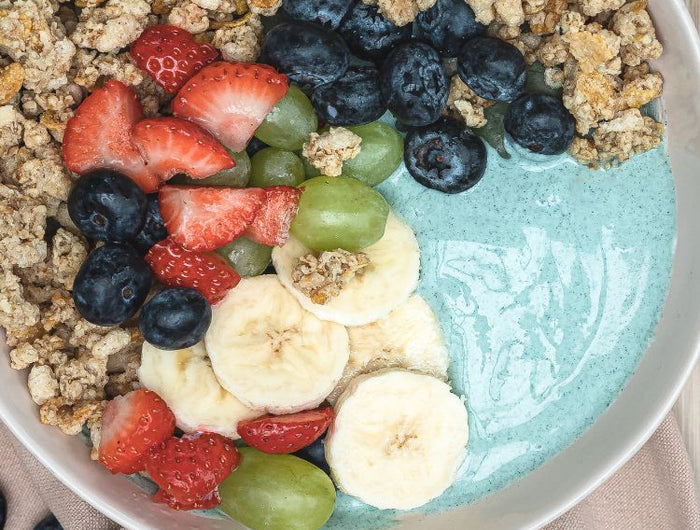

Spirulina
Benefits of Nature's Most Nutritious Food


Today, so many health issues come from a lack of nutrients in our agriculture. Well, where agriculture falls short, aquaculture is quickly picking up the slack! Spirulina is a type of algae that has been recognized (along with chlorella) as one of the world’s healthiest foods. With a laundry list of research-backed health benefits, including obesity reduction, and immune support, it’s no wonder why so many people are turning to spirulina as a source of balanced nutrition.
Scientists have found that Spirulina has “immune-stimulant activities. It is able to increase the production and activity of bone marrow stem cells, macrophages, and T-cells. It improves cell nucleus enzyme activity, and DNA repair capacity. As such, it has a role in cancer treatment and inhibits HIV-1 replication in human-derived T-cell lines” (Ramasubramania Raja, 2016). [1] Other scientists confirm that “Spirulina contains functional compounds, such as phenolics, phycocyanins, and polysaccharides, with antioxidant, anti-inflammatory, and immunostimulating effects”. “Spirulina not only supports the immune system but its ability to reduce inflammation makes it “ useful in the prevention of the metabolic syndrome which is characterized by low-grade inflammation, oxidative stress, and intestinal dysbiosis” (2)
Algae (in the form of cyanobacteria) were some of the first life on Earth almost 4 billion years ago. Before this form of algae, most living organisms were anaerobic, meaning they did not rely on oxygen to produce energy. Cyanobacteria, on the other hand, convert sunlight (photosynthesis) for energy – the byproduct being Oxygen (O2).
As these algae began to thrive, they released a tremendous amount of oxygen into the atmosphere. Studies indicate that approximately 80% percent of the Earth’s atmospheric oxygen has been produced by algae and other forms of marine phytoplankton. [3] The large increase in atmospheric oxygen set the stage for aerobic, or oxygen consuming, organisms to make their first appearance. The first aerobic organism evolved over billions of years into the humans and other animals that populate the Earth today.
So, next time you take a breath, be sure to thank algae!
Of course, spirulina is great for much more than just oxygen. New technology allows us to use spirulina as a source of sustainable fuel, nutritious animal feed, and natural food coloring. But long before we made use of it in these ways, humans were eating it for its incredible nutrients.
Humans have cultivated and consumed spirulina for at least 700 years (and likely over 1,200 years). It was a staple in the diets of the Aztec Empire in Mexico and the Kanem Empire in Chad. These early civilizations would filter spirulina out of lakes and dry it to produce spirulina "cakes" (similar to the way we make spirulina tablets today). These spirulina cakes were an essential part of these early peoples’ diet, providing large amounts of protein and micronutrients.
While the Aztecs and Kanembu did not have the technology to quantify the nutrition in their spirulina, modern science certainly backs up their food staple. In fact, the United Nations declared spirulina to be "the best food for the future" at its World Health Conference in 1974. [4]
The two most studied and promising types of algae for human consumption are spirulina and chlorella. While they are often mentioned in the same breath, what they do in your body is night and day. Spirulina is particularly good for energy because it has no cell wall. It takes little time to digest, making it an instant source of vitamins and protein. Chlorella, on the other hand, has one of the strongest cell walls in the plant kingdom. It digests very slowly, allowing its high chlorophyll content to detoxify your body.
Since spirulina is so nutrient-dense, many of its nutrients are in higher quantities per gram than most foods. We could go on and on about the health benefits of spirulina’s high concentrations of amino acids and micronutrients like Tryptophan, Vitamin B3 (Niacin), and Iron. Instead, we’re going to highlight five of the most impressive health benefits of spirulina found by scientific research.
There’s a physical trait that everyone shares. Whether you’re an Olympic athlete or a once-per-year gym goer, we all have limits to how far we can push our bodies. Eventually, your muscles are simply too damaged to continue to function. Research shows that spirulina supplementation reduces muscle fatigue and postpones the point of exhaustion. [5]
Spirulina was also found to increase fat loss in healthy adults. Taking a 6-gram dose of spirulina prior to moderate cardio decreased oxidative damage, decreased glucose oxidation, and increased the amount of fat being burned for fuel. [6]
Along with preventing oxidative damage in the muscles, spirulina can also prevent oxidative damage in the brain. One study found that spirulina reduced the levels of a harmful protein in the brain, suggesting that spirulina supplementation can help prevent memory loss. [7]
Another study found that spirulina reduced neurotoxicity and inflammation in the brain. Inflammation is a major contributor to several major neurodegenerative diseases, including Parkinson’s disease, on which this study focused. [8]
Multiple double-blind studies demonstrate spirulina’s ability to improve health markers in obese patients. These studies range from supplementing 2 grams to 8.4 grams of spirulina for anywhere from 4 to 18 weeks.
Common among them was that the researchers in all studies found statistically significant reductions body mass, body mass index (BMI) waist circumference. They recorded lower LDL (bad) cholesterol, higher antioxidant levels, and better insulin sensitivity. [9]
Some studies show that spirulina is a potent remedy for cardiovascular diseases such as atherosclerosis (plaque build up in arteries) and endothelial dysfunction (poor circulation). [8] [10] This research indicates that spirulina is a promising alternative to risky weight management drugs for people struggling with obesity.
Spirulina has also been used in part as a treatment for hypoglycemia. Research shows that spirulina can reduce blood glucose and lipid profiles while preventing metabolic issues associated with excessive fructose. [10]
The state of our environment is not ideal. It’s a difficult reality, but the air we breathe, the water we drink, and the food we eat all contain unnaturally high levels of harmful substances. Pollution in our daily lives makes supporting your body’s detox efforts vital.
Arsenic is a heavy metal, a carcinogen, and a literal poison. It is lethal at 70mg but can slowly deteriorate human health at much lower levels. Spirulina has been shown to reduce arsenic levels in humans. 250mg of spirulina along with 2mg of zinc two times a day for 16 weeks was an effective treatment for chronic arsenic poisoning. [11]
We won’t kid you, spirulina is definitely an acquired taste. But before you abandon ship, think back to when you were a kid and saw your parents drinking a brown, bitter sludge they called "coffee." You probably thought "YUCK" and wondered how they could possibly drink such gross looking stuff? Well, fast forward to today and we bet you can’t imagine life without coffee (or at least most of you can’t). Sometimes, your palate just needs to make some adjustments!
You can certainly chew spirulina. You can even add it to smoothies or salads. But here’s the thing – for many people, when something healthy doesn’t taste like candy, they stop eating it. If that sounds like you, you’re going to want to buy spirulina tablets instead of powder. That way, it’s easier to swallow without getting too much "green" taste. It’s also important to know the size of the tablets you buy. Many companies use 500mg and all the way up to 1-gram tablets! We recommend 250mg tablets. They are much easier to swallow – especially if you want to give them to children.
Lastly, be sure not to cook with spirulina. Salads and smoothies are fine! Studies show that excessive heat eliminates some of its nutrition. Keeping your spirulina in the refrigerator can help maintain the flavor, but you don’t have to worry about leaving it at room temperature – even on an especially hot day.
Spirulina is a food crop just like broccoli or kale – you grow it, you harvest it, you clean it, you eat it! While algacultural techniques vary, the best spirulina is grown naturally in outdoor tanks monitored for purity.
While we cannot speak for the entire spirulina industry, the ENERGYbits spirulina growing method is all natural. We use no artificial chemicals or pesticides. We grow the spirulina in pristine, freshwater tanks, harvest it, dry it, and press it into tablets. Our spirulina is tested three times for purity (and is consistently 100% pure) before you receive it. That means all you are getting is pure spirulina, just as nature intended!
Just like the meat you eat and the coffee you drink – not all spirulina is created equal. Climate, growing conditions, and equipment are all important factors to considering when finding the highest quality spirulina. Next time you are looking for a new spirulina brand, ask yourself these questions:
Taiwan has very high standards for its algae growers and an established, well-regulated algae industry. There are no environmental toxins for the algae to absorb due to the island’s pristine climate. Unfortunately, finding spirulina products sourced from Taiwan can be difficult, as the superior quality of the product makes it much more expensive. Hawaiian spirulina is another safe option, but its quality is more variable than Taiwan because of a shorter history of growing.
Countries like China, India, and (to a lesser extent) Korea are large exporters of cheap spirulina; however, their highly polluted environments and lack of regulations make their algae a dangerous choice for human consumption. Japan also has an algae industry, but because of radioactivity concerns and studies showing higher levels of heavy metals, [12] it is another exporter to best avoid.
This question is particularly difficult to answer. One issue is a large number of fraudulent certifications in the algae industry (mostly coming from China). The other issue is that USDA Organic certification actually negatively impacts the nutritional quality of spirulina in some cases. [13] So, while a product may look high quality, the reality could be much different. The best spirulina products are tested by a third party that verifies no heavy metals, pesticides, or additives.
It’s a smaller concern because it is less common, but some spirulina is grown in the ocean. There is a higher risk of contamination growing this way. One way to check this is to look at the spirulina’s iodine content. If the spirulina contains iodine, it was likely grown in the ocean.
Spirulina is a superfood like no other. As a healthy, sustainable food, you can expect to see it much more in the future. If you’re interested in getting ahead of the curve and adding spirulina to your diet, be sure to check out ourENERGYbits® Spirulina. It is 100% natural and additive-free – simply pure Taiwanese spirulina grown in outdoor, freshwater tanks.
Learn about the many benefits of Spirulina algae in this short but informative interview with ENERGYbits Founder/CEO Catharine Arnston.